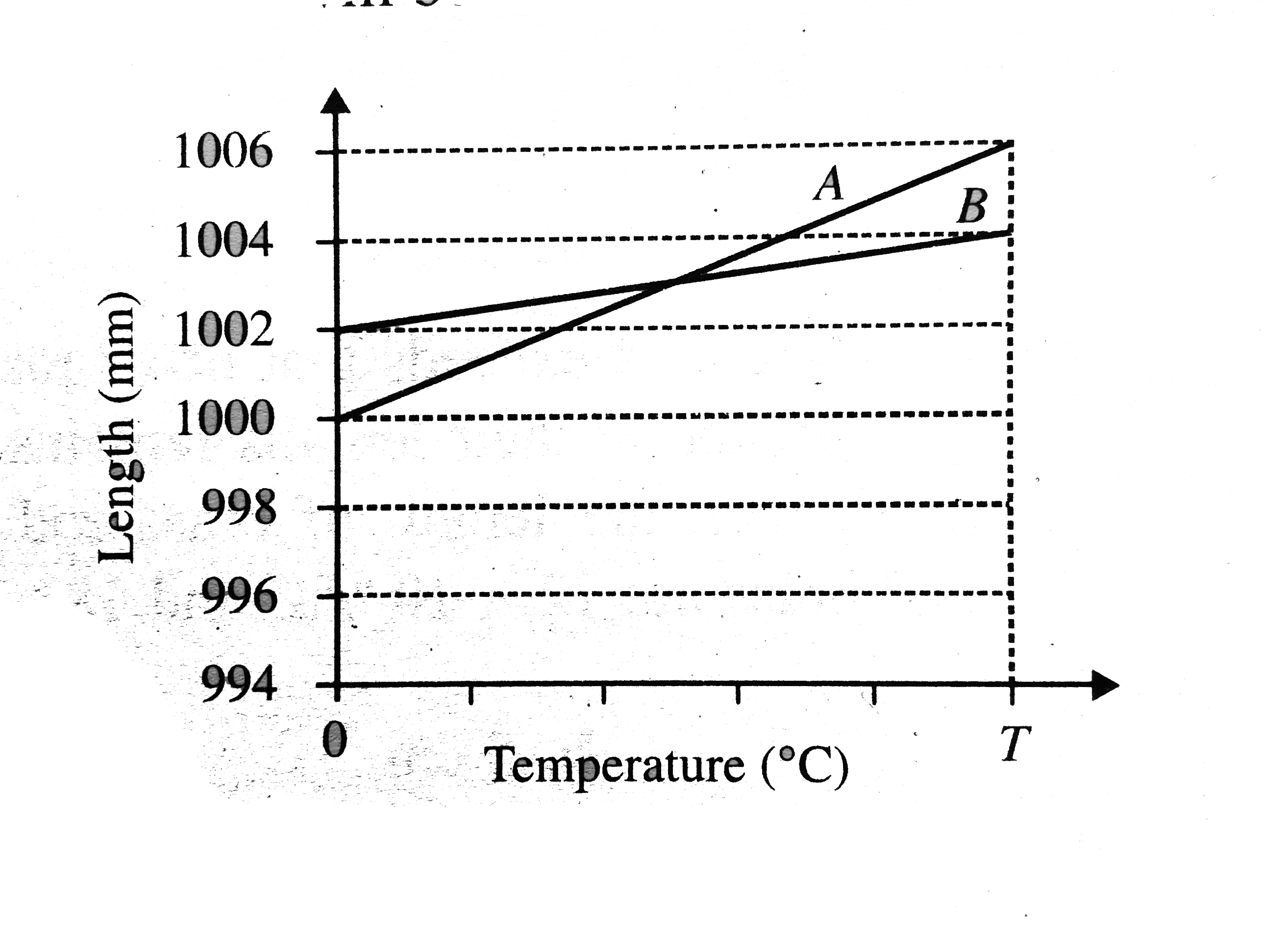Length of wire at room temperature is 4.55 m , when the temperature increases upto 100∘C then its length becomes 4.57 m . The coefficient of linear expansion (α) of the given wire is
5.021×10−5K−1
6.021×10−5K−1
7.021×10−5K−1
8.021×10−5K−1
The correct Answer is:D
To find the coefficient of linear expansion (α) of the wire, we can follow these steps:
Step 1: Understand the formula for linear expansion
The formula for linear expansion is given by:
L2=L1(1+α(T2−T1))
Where:
- L1 = original length of the wire at initial temperature T1
- L2 = new length of the wire at temperature T2
- α = coefficient of linear expansion
- T1 = initial temperature
- T2 = final temperature
Step 2: Identify the given values
From the problem:
- L1=4.55m
- L2=4.57m
- T1=27∘C (room temperature)
- T2=100∘C
Step 3: Convert temperatures to Kelvin
To use the formula, we can convert the temperatures to Kelvin:
- T1=27∘C+273=300K
- T2=100∘C+273=373K
Step 4: Calculate the change in temperature
Now, calculate the change in temperature:
ΔT=T2−T1=373K−300K=73K
Step 5: Substitute values into the linear expansion formula
Now, substitute the values into the linear expansion formula:
4.57=4.55(1+α⋅73)
Step 6: Solve for α
First, divide both sides by 4.55:
4.574.55=1+73α
Now, calculate 4.574.55:
4.574.55≈1.0044
So we have:
1.0044=1+73α
Now, subtract 1 from both sides:
0.0044=73α
Now, divide both sides by 73 to solve for α:
α=0.004473≈6.021×10−5K−1
Final Answer
The coefficient of linear expansion α of the given wire is approximately:
α≈6.021×10−5K−1
---
The formula for linear expansion is given by:
L2=L1(1+α(T2−T1))
Where:
- L1 = original length of the wire at initial temperature T1
- L2 = new length of the wire at temperature T2
- α = coefficient of linear expansion
- T1 = initial temperature
- T2 = final temperature
From the problem:
- L1=4.55m
- L2=4.57m
- T1=27∘C (room temperature)
- T2=100∘C
To use the formula, we can convert the temperatures to Kelvin:
- T1=27∘C+273=300K
- T2=100∘C+273=373K
Now, calculate the change in temperature:
ΔT=T2−T1=373K−300K=73K
Now, substitute the values into the linear expansion formula:
4.57=4.55(1+α⋅73)
First, divide both sides by 4.55:
4.574.55=1+73α
Now, calculate 4.574.55:
4.574.55≈1.0044
So we have:
1.0044=1+73α
Now, subtract 1 from both sides:
0.0044=73α
Now, divide both sides by 73 to solve for α:
α=0.004473≈6.021×10−5K−1
The coefficient of linear expansion α of the given wire is approximately:
α≈6.021×10−5K−1
Topper's Solved these Questions
- THERMAL PROPERTIES OF MATTERBOOK - NCERT FINGERTPS ENGLISHCHAPTER - THERMAL PROPERTIES OF MATTEREXERCISE - Specific Heat
5 Videos
- THERMAL PROPERTIES OF MATTERBOOK - NCERT FINGERTPS ENGLISHCHAPTER - THERMAL PROPERTIES OF MATTEREXERCISE - Calorimetery
4 Videos
- THERMAL PROPERTIES OF MATTERBOOK - NCERT FINGERTPS ENGLISHCHAPTER - THERMAL PROPERTIES OF MATTEREXERCISE - Measurement of Temperature
2 Videos
- SYSTEM OF PARTICLES AND ROTATIONAL MOTIONSBOOK - NCERT FINGERTPS ENGLISHCHAPTER - SYSTEM OF PARTICLES AND ROTATIONAL MOTIONSEXERCISE - NCERT Exemplar
8 Videos
- THERMODYNAMICSBOOK - NCERT FINGERTPS ENGLISHCHAPTER - THERMODYNAMICSEXERCISE - Assertion And Reason
15 Videos
Similar Questions
A steel beam used in the construction of a bridge has a length of 30.0 m when the temperature is 15∘C. On a very hot day, when the temperature is 35∘C, what will the beam's change in length be? (The coefficient of linear expansion for structural steel is +1.2×10−5/∘C.)
View SolutionTwo rods A and B of identical dimensions are at temperature 30∘C. If A is heated upto 180∘C and B T∘C, then new lengths are the same . If the ratio of the coefficients of linear expansion of A and B is 4:3,then the value of T is
View Solution
Knowledge Check
The volume of a metal sphere increases by 0.24% when its temperature is raised by 40∘C . The coefficient of linear expansion of the metal is .......... .∘C
A2×105.∘C−1B6×10−5.∘C−1C18×10−5.∘C−1D1.2×10−5.∘C−1
A concrete slab has a length of 10 m on a winter night when the temperature is 0∘C. Find the length of the slab on a summer day when the temperature is 35∘C. The coefficient of linear expansion of concrete is 1.0×10−5C−1.
View SolutionA concrete slab has a length of 10 m on a winter night when the temperature is 0∘C. Find the length of the slab on a summer day when the temperature is 35∘C. The coefficient of linear expansion of concrete is 1.0×10−5∘C−1.
View SolutionA metallic wire with tension T and at temperature 30∘C vibrates with its fundamental frequency of 1kHz. The same wire with the same tension but at 10∘C temperature vibrates with a fundamental frequency of 1.001kHz. The coefficient of linear expansion of the wire is equal to 10−K.∘C. Find 2K.
View SolutionA glass cylinder contains m0=100g of mercury at a temperature of t0=0∘C. When temperature becomes t1=20∘C the cylinder contains m1=99.7g of mercury The coefficient of volume expansion of mercury γHe=18×(10−5/∘C Assume that the temperature of the mercury is equal to that of the cylinder. The coefficient of linear expansion of glass α is
View SolutionA metal wire with volume density ρ and young's modulus Y is stretched between rigid supports. At temperature T, the speed of a transverse wave is found to be v1. When temperature decreases T−ΔT, the speed increases to v2. Datermine coefficient of linear expansion of wire.
View SolutionA glass cylinder contains m0=100g of mercury at a temperature of t0=0∘C. When temperature becomes t1=20∘C the cylinder contains m1=99.7g of mercury The coefficient of volume expansion of mercury γHe=18×(10−5/∘C Assume that the temperature of the mercury is equal to that of the cylinder. The corfficient of linear expansion of glass α is
View Solution
The variation of length of two metal rods A and B with change in temperature is shown in Fig. the coefficient of linear expansion αA for the metal A and the temperature T will be
View Solution
